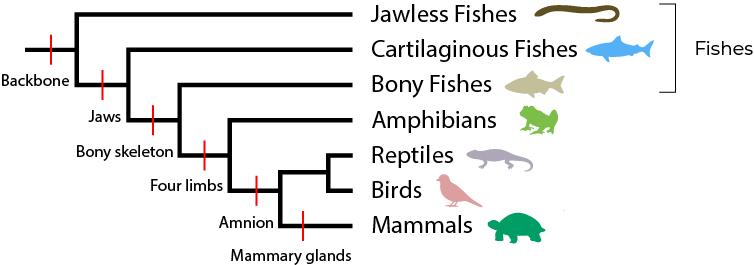7.1 General Features of Vertebrates
Vertebrates are among the most recognizable organisms in the animal kingdom. If you were to list the first five animals that come to mind, there’s a high chance they would all be vertebrates.

Like echinoderms, vertebrates possess an endoskeleton. However, vertebrate endoskeletons are unique in that they include a skull and a backbone, which protects the spinal cord. The backbone is made up of a series of bones called vertebrae, which is where the name “vertebrates” comes from. These animals also have closed circulatory systems, well-developed nervous systems, and complex internal organs.
Vertebrates are a diverse group within the phylum Chordata, with over 62,000 identified species. They are traditionally classified into five major groups: fishes, amphibians, reptiles, birds, and mammals.

Figure 7.1.2 Image Description
The image is a simplified phylogenetic tree showing the evolutionary relationships among major vertebrate groups. Branch points are marked with evolutionary traits: backbone, jaws, bony skeleton, four limbs, amnion, and mammary glands. From left to right, the tree branches into jawless fishes (illustrated by a worm-like figure), cartilaginous fishes (shark icon), bony fishes (fish icon), amphibians (frog icon), reptiles (lizard icon), birds (bird icon), and mammals (turtle-like icon). The diagram highlights that all vertebrates share a backbone, while additional traits define each subsequent group.
“15.6 Vertebrates” from 15.6 Vertebrates by Colleen Jones is licensed under a Creative Commons Attribution-NonCommercial-ShareAlike 4.0 International License, except where otherwise noted.

